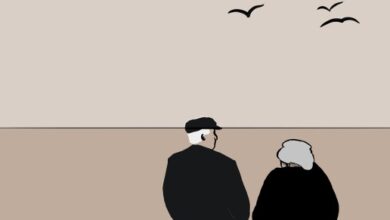
The Indigo Terror, written by Satyajit Ray, is a first-person account of a haunting occurrence. When the main character, Aniruddha, spends an unplanned night in an old bungalow, he experiences an almost paranormal phenomenon. Indigo is replete with instances of Ray’s masterful use of horror and suspense which has the ability to capture the attention of the reader right till the end of the story.
The Indigo Terror | Summary
The story begins with the main character, Aniruddha Bose, giving the readers a self-introduction. He is a twenty-nine-year-old bachelor working in an advertising agency, who enjoys doing writing work on the side. However, for the past few months, he has not been writing- he has been reading up about the 19th century indigo plantations in Bihar and Bengal, to the point he may even be considered an expert. He then gives a little insight to his family background- he has an older brother who has been living in London, and his father was a popular physician in Bihar who passed away when Aniruddha was 17.
After this, Aniruddha and his mother moved to his uncle’s house in Bengal, where he got his bachelor’s degree. Despite this, he cannot shake away some habits built in his early years, such as the desire to get away from city bustle. It is because of this that he bought a car, and when his friend Promode wrote to him asking him to come visit in Dumka, he agreed. From the very beginning, there were a few hitches in Aniruddha’s plan to leave early, with his neighbors stopping him to talk and ask questions. He finally managed to set off, describing his journey through the cities and the clear blue sky. One of his tyres got punctured, and he got out of the car to fix it. However, a few miles later he encountered a heavy thunderstorm and another flat tyre. With the rain pouring, no spare tyres and the night falling, he was left in a predicament.
He realizes that he had made a wrong turn and reached a dead end, with no repair shops nearby. In his moment of nervousness, he spotted a light in the distance that looked like a window. Taking out his torch, he set out to see if he could find any help- and he was in luck. An old man named Sukhanram offered him shelter in the Dak Bungalow, and even offered to give him some chapatis to eat. Aniruddha found out that the Bungalow used to be the home of a sahib- an indigo planter. The factory was close by, but only the chimney remained standing.
That night, Aniruddha was awoken by the sound of scratching on the door. From the howls, he could tell that it was a hound. When he raised his hand to check the time on his wristwatch, he was startled to realize that it was gone, and so was his suitcase. He wondered whether there were thieves, but they could not have climbed in through the barred windows. Slowly, he started to experience more shocking changes– his hands had become pale, his voice like that of an Englishman, his clothes different. And when he turned to the room again, it had changed completely. He was a different person in a different place, his body was not acting of his own accord, yet his consciousness was still that of Aniruddha.
Unable to control himself, he wrote a letter as though he were an Englishman. He wrote as though it was the 27th of April, 1968, about how he was about to die and nobody would mourn his loss because of how badly he had treated them- yet he couldn’t resist the lure of indigo. He wants to be buried with his wife and son, but he worries for his hound, Rex, for surely the people would stone him and mistreat him after his owner’s passing. And then he suddenly stopped writing. Aniruddha got up- his mind was his own, yet everything else was that of the Englishman, and he could not stop himself when he reached for a pistol. When he called out for Rex, his voice was a deep, English one. He shot Rex dead, the noise causing chaos in the direction of the factory, and then he bolted the door and held the pistol to his own ear.
And then just as suddenly as Aniruddha was thrust into this memory, he was awoken from it. It was the 28th of April, but in the present day. His car had been fixed and he was being offered tea– it was as though the wild and terrifying night had never happened. Aniruddha doubts anyone would believe him, anyway- this unbelievable incident that took place on the 100th death anniversary of one of the indigo tax lords.
The Indigo Terror | Analysis
Satyajit Ray is known for plot twists and surprise endings. He is regarded as one of India’s best horror short story writers, with several of his works revolving around supernatural phenomenon, spirits, ghosts and other paranormal activity. What stands out is the way he writes these elements in such a realistic manner that it does not seem like an alternate paranormal reality– it truly feels as though the reader is reading about a person’s everyday life in a normal world. The subtle insertions and enormous impact of these horror aspects makes one feel as though it is so possible that they may experience it themselves. We can see this in his short story The Indigo Terror, where the main themes are paranormal activity, unsettled pasts, shapeshifting and loss of control.
The Indigo Terror is written in first-person through the narrator, Aniruddha. What makes this narration more interesting is that Aniruddha seems to be directly addressing the readers several times- for example, “My name is Aniruddha Bose.”, “At this point I must tell you something about my past.”, “This is what I wrote” and “Would anyone believe the experience I had on the hundredth death anniversary of one of Birbhum’s indigo tax lords?”. Such an address makes it seem as though he is acknowledging the reader, in a sense breaking the fourth wall and thus making the reader feel closer to both the story itself and the character. Ray employs vivid imagery (e.g. “a clear blue sky free from chimney smoke” and “air so pure and so redolent of the smell of earth”) symbolism and descriptions which stirs anticipatory emotions within the readers. It is also important to note that the original story was in Bengali and has been translated to English.
The foreshadowing that something will go wrong is hinted at from the beginning– when he is delayed by his neighbours’ conversation, he says “there was a snag right at the start.” which also indicates that Aniruddha, now looking back, is able to pinpoint all the signs. This story is mostly in past-tense, besides the narrator’s self-introduction, which means he is recollecting the experience. Further, the emphasis on the rumbling thunder was a warning. Thunderstorms often represent difficulty and problems in literature, and hence it symbolizes the upcoming terror. Other obstacles, such as missing a turn and two flat tyres were also hints that the journey would not be a pleasant one.
Time and date also play an important role in this story. As he was about to leave, he “glanced at his wristwatch”, and once again did so in the room at the Bungalow, when he realized the watch had gone missing. Date is an essential aspect, as when he transforms into the Englishman, he is living in a date 100 years in the past, as mentioned in the letter, and the date is mentioned again when he returns to present reality. These constant appearances of time act as an anchor through the story and help the readers understand the shifts that take place. The watch symbolizes the border between Aniruddha in his true self and body and in the Englishman’s body. He realized his transformation on seeing the watch’s disappearance, and the 100th death day of the indigo tax collector is a reference to time. This may also be the reason why Aniruddha specifically says “because it was an automatic watch” which means it would have shown the date as well.
One of the biggest themes in this story is that of being of conscious mind but not having control of one’s own body. When Aniruddha experienced a paranormal activity of sorts, he knew who he was and could remember every detail to recall it. Yet he could not control his actions– it was his mind in someone else’s body. This portrays emotions of helplessness, as he was unable to stop himself. Further, he transformed into the very body of the Englishman, implying shapeshifting. It seemed to be a sort of dream, but it is more aligned with horror and paranormal activity because (a) the conscious mind in a different body, (b) the fact that Aniruddha was reliving the Englishman’s last moments, which truly did happen in that room and (c) the significance of the date. It cannot be called possession of a body, because it was not Aniruddha’s own body.
Indigo itself plays an enormous role in the story. In this context, it may represent greed and mistreatment, for the Englishman was an indigo tax collector who said he “could not resist it”, meaning he may have been lured in by the promise of money. He also mentions that nobody would mourn his death because of how bad he was to them- this implies that he has mistreated the indigo plantation workers, and that because of their job they had to suffer a great deal at his hands.
An unrested soul and an unsettled past is another theme of Indigo– the soul of the indigo tax collector was hardly at peace in his last moments, which Ray portrayed through Aniruddha. It is interesting to notice that because the stream of consciousness is still Aniruddha’s, his thoughts at the moment of living the memory would be different from what the Englishman himself had been thinking 100 years ago in that situation. However, Ray conveyed the exact same feelings of fear, confusion, anxiety and rashness through Aniruddha, despite him being mentally conscious. This was done by using Aniruddha’s shock at his own transformation to project a similar aura of emotion– this enables the readers to sense not only Aniruddha’s plight, but also understand the overall mood of the room when the Englishman breathed his last.
Besides being the 100th death day, one may wonder why a late soul was in such a rattled state. Why was the 100th death day not spent calmly, but instead in traumatizing a guest? It may be the fact that the Englishman’s last action before his own suicide was shooting his beloved dog, Rex. Though his intentions were good, the act was still a terrible one, and the guilt may have caused a permanent element of unrest in his spirit. At the very end of the story, Aniruddha is back in his own body in present time. The events of the night seemed so unimaginable that he wondered if anybody would believe him. When he is informed that his car has been repaired, it symbolizes the end of his terrifying experience. The car breaking down in the night symbolized disruption, which Aniruddha experienced in the room. Now that the tyres have been repaired, he can proceed smoothly- symbolizing that his bad luck had passed. The fact that Ray waited for the last line of the story to reveal that it was the Englishman’s 100th death day is in line with his writing style- a surprise ending. On reading it, we have so many questions- yet, at the same time, so many things seem to fall in place.

